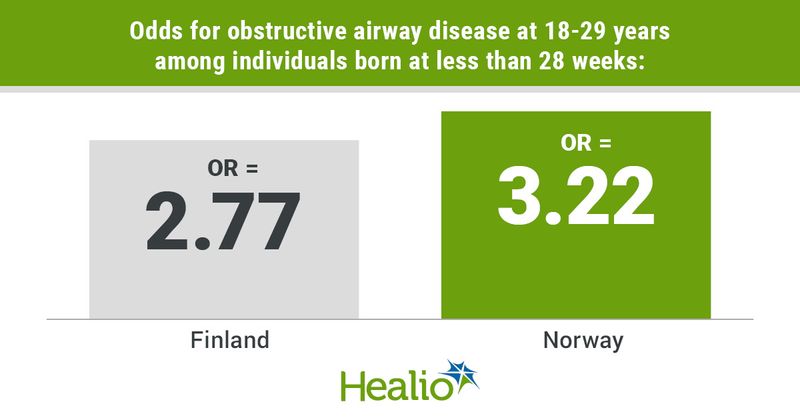Preterm birth elevates odds for adulthood COPD, asthma
Key takeaways:
- Being born preterm increased the risk for adult obstructive airway disease.
- A heightened risk was found in preterm infants born small for gestational age or who had bronchopulmonary dysplasia.
Individuals born preterm had greater odds for asthma and COPD as an adult than those born full term, according to results published in European Respiratory Journal.

“Our results support the idea that COPD is a heterogeneous disease and although smoking is still by far the most important risk factor, early life factors also play a role,” Anna Pulakka, PhD, senior researcher at University of Oulu and the Finnish Institute for Health and Welfare, told Healio. “Preterm birth and other early life conditions should be recognized as risk factors for respiratory conditions in adulthood.”

In a nationwide register study, Pulakka and colleagues analyzed 706,717 individuals (50.9% men) born in Finland between 1987 and 1998, as well as 1,699,528 individuals (51.1% men) born in Norway between 1967 to 1999, to determine how gestational age is related to asthma and COPD care episodes in individuals aged 18 to 50 years.
Researchers figured out the likelihood for a health care episode of each obstructive airway disease by using logistic regression.
From the Finland cohort, 4.8% of infants were born preterm, and in the Norway cohort, 5% were born preterm. From both country cohorts combined, 45,624 individuals experienced a relevant care episode and received a diagnosis of asthma (n = 41,332), COPD (n = 2,706) or both (n = 1,586) in follow-up.
When compared with infants born within 39 to 41 weeks (full term), those born at less than 28 weeks faced heightened odds for obstructive airway disease, especially at 18 to 29 years old in both cohorts (Finland OR = 2.77; 95% CI, 1.91-4.02; Norway OR = 3.22; 95% CI, 2.4-4.31). Odds greater than 1 but less than 2 were observed in the other preterm age groups, according to researchers.
Researchers continued to observe elevated odds for adulthood obstructive airway disease in those with a gestational age of less than 28 weeks in Norway at 30 to 50 years old (OR = 2.96; 95% CI, 1.98-4.43) and at 18 to 50 years old (OR = 3.12; 95% CI, 2.42-4.03). Additionally, these odds did not change when adjusted for covariates, according to researchers.
Besides individuals born 32 to 33 weeks preterm in Finland, researchers found increased odds for asthma across all preterm ages.
Researchers did not find any care episodes of COPD in the less than 28 weeks or the 28 to 31 weeks preterm groups born in Finland, but in Norway, they observed elevated odds for COPD in the 18- to 29-year-old group in every preterm gestational age except weeks 37 to 38 (less than 28 weeks OR = 18.92; 95% CI, 9.3-38.46; 28 to 31 weeks OR = 6.69; 95% CI, 4-11.18; 32 to 33 weeks OR = 3.13; 95% CI, 1.72-5.7).
Looking specifically at individuals aged 30 to 50 years old, researchers found that several gestational ages of preterm birth heightened the risk for COPD (less than 28 weeks OR = 7.44; 95% CI, 3.49-15.85; 28 to 31 weeks OR = 3.18; 95% CI, 2.23-4.54; 32 to 33 weeks OR = 2.32; 95% CI, 1.72-3.12).
Further, the risk for emphysema in adulthood was elevated in individuals born less than 28 weeks preterm (18 to 29 years OR = 31.09; 95% CI, 7.54-128.14; 30 to 50 years OR = 16.66; 95% CI, 4.13-67.12; 18 to 50 years OR = 21.68; 95% CI, 6.47-71.63).
Additionally, in Finland, bronchopulmonary dysplasia in combination with preterm birth at less than 28 weeks (adjusted OR = 4.79; 95% CI, 2.88-7.99 vs. 1.91; 95% CI, 1.1-3.33) or between 28 to 31 weeks (aOR = 8.17; 95% CI, 5.15-12.93 vs. 1.76; 95% CI, 1.34-2.31) raised the odds for obstructive airway disease in adulthood compared with those without bronchopulmonary dysplasia.
Those born between 28 to 31 weeks and classified as small for gestational age also faced increased chances for obstructive airway disease compared with those born preterm and appropriate for gestational age in both countries (Norway: aOR = 2.36; 95% CI, 1.58-3.52 vs. 1.92; 95% CI, 1.57-2.34; Finland: OR = 2.8; 95% CI, 1.64-4.78 vs. 2.22; 95% CI, 1.71-2.88).
As the gestational age went up, researchers observed lower odds for obstructive airway disease as an adult in sensitivity analysis. Further, researchers found that risk for obstructive airway diseases in relation to gestational age did not differ based on sex, socioeconomic status, maternal age, maternal asthma or maternal smoking during pregnancy.
When asked if similar results could be expected in the United States, Pulakka said yes but added that there may be a slight difference.
“The incidence of preterm birth is about twice as high in the United States (CDC estimation about 10%) than in our study population in Finland and Norway (about 5%), thus the proportion of individuals affected by preterm birth is much higher in the United States,” she said.
“Future studies are needed to see how children born preterm today and treated with the current care will do when they are adults,” Pulakka told Healio. “The individuals in our study were all born before 2000. Future studies will also have a longer follow-up until middle age and will clarify the role of preterm birth in the development of COPD.”
For more information:
Anna Pulakka, PhD, can be reached at anna.pulakka@thl.fi.
Reference:
- Children born preterm are more likely to have asthma or COPD in adulthood. https://thl.fi/en/web/thlfi-en/-/children-born-preterm-are-more-likely-to-have-asthma-or-copd-in-adulthood. Published March 30, 2023. Accessed March 31, 2023.
